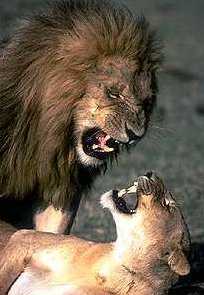
Lion Facts
Felidae Panthera leo
Sizes:
Weight:
330-550 lbs
Length:
Head/Body
5.4 to 8.25 ft.
Tail
36-41 inches
Shoulder Height:
4 Ft; Male can be 50% larger than Female
Lifestyle:
Habit:
Live in family groups called prides; lionesses do most of the hunting and the males defend the territory.
Diet
Zebra, buffalo giraffe, carrion, wildebeest
Lifespan:
Up to 16 years
Breeding
Sexual Maturity:
18 months
Mating:
Throughout the year
Gestation:
102-113 days
Number of Young:
1 to 4
Birth Interval
18-26 months
Location:
Found in open savannah and desert areas of Africa south of the Sahara; also a small population in the Gir Forest National Park in northwest India
Conservation:
Competition from humans for grassland has led to a drastic reduction in the lion's range. Lions now survive in greatest number where humans are sparse. Licensed hunting for sport continues in some areas, but the lion is protected in national parks, such as the Masai Mara in Kenya.
Related Species
There is an Asiatic subspecies of lion, Panthera leo persica, with a population of about 300. The big cats of the genus Panthera also include the jaguar, the tiger, the leopard, and the snow leopard. A further 30 species are classified in the family Felidae, including the cougar, three species of lynx, and 26 species of 'small cat' such as the ocelot.
Other Facts:
A lion's resounding roar can be heard more than six miles away.
Slow compared to a cheetah, a lion can still sprint up to 33.6 mph.
A lioness also suffocates prey by clamping her jaws over its mouth and nostrils.
Until about 10,000 years ago, lions could be found in North America.
Individual lions hunt effectively, but are more than twice as successful at catching large prey, such as zebra, when they work as a team.
This page hosted by 
Get your own Free Home Page